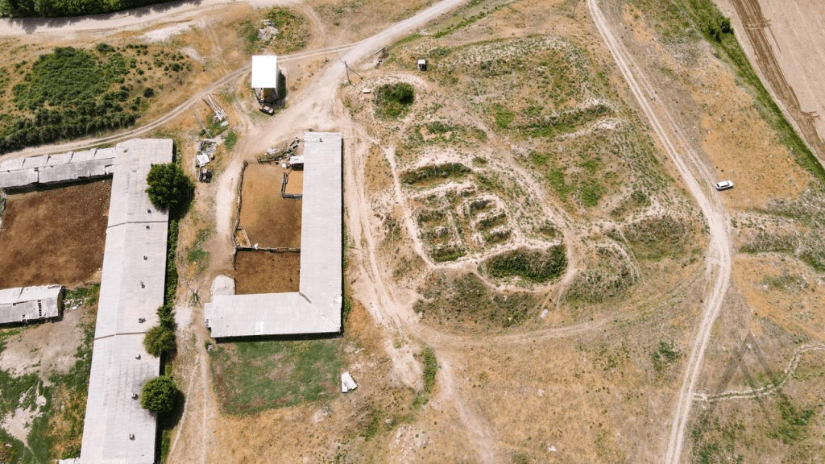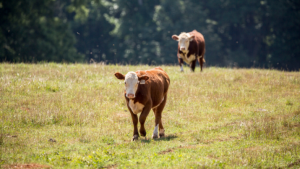
The unearthed ruins of a historic Buddhist temple in Kyrgyzstan, part of the UNESCO-listed Krasnaya Rechka World Heritage Site, are to be opened to the public in mid-September. The ancient monastery, which was constructed more than a thousand years ago, was the second Buddhist temple to be discovered close to Krasnaya Rechka (City of Nevaket) in 2010.
According to local archaeologist Valery Kolchenko, the temple is the only extant site made entirely of clay. It housed an 11-meter Buddha statue in the reclining nirvana posture—parts of which have been placed in a Russian heritage museum in St. Petersburg.
“All of our medieval archaeological sites are made of clay. We don’t have stone ones; we practically don’t have brick ones, with rare exceptions. It’s all made of clay,” said Kolchenko. (Arkeonews)
Kolchenko added that the Buddha statue was made of brick “with clay smeared on top to form the shape of his clothes, hands, and head.” He pointed out that it was impossible to see the complete Buddha statue in its original setting.
“A Buddhist couldn’t even see him in his entirety because the walls wouldn’t allow it. Only a part of the face, arms, and legs could be seen. But even to touch this was to acquire some form of sanctity,” Kolchenko explained. (Arkeonews)

The ancient temple, which was founded along in the Chang’an-Tianshan corridor of the Silk Road, was restored as part of a collaborative initiative between UNESCO and the European Union.
The corridor, which runs some 5,000 kilometers from China’s Chang’an to the Zhetysu region of Kazakhstan, is an excellent example of a physical space that has morphed into a cultural icon. There are 33 recognized ancient sites situated along the corridor—22 in China, eight in Kazakhstan, and three in Kyrgyzstan.
In the Kyrgyz portion of the Chang’an Tianshan Corridor, the three ancient sites are the city of Suyab, which is home to the ancient settlement of Ak-Beshim; the city of Balasagun, which is the location of the Burana Tower; and the city of Nevaket, home to the Krasnaya Rechka World Heritage Site. These cities are located in the Chui Valley, which is highly regarded as one of the most beautiful landscapes in all of Kyrgyzstan.
In the Chui Valley, towns and monumental buildings from the 5th–12th centuries were uncovered by archaeologists between 1940 and 2000. These sites reflect the cultural and artistic traditions of numerous nations and peoples, from Byzantium in the west to India in the south and China in the east.
In 1953–54, archaeologist L. R. Kizlasov excavated several structures in Suyab. Two of those excavated structures were Buddhist temples.
Krasnaya Rechka has long been recognized as one of the most significant urban settlements in the Chui Valley and Tien-Shan region. A Zoroastrian fire altar and cemetery in the western suburbs, Nestorian Christian votive stones in the citadel, and two Buddhist temples south of the town walls have all been unearthed during excavations in and around the city.
A unique example of the intercultural interaction taking place in in the Chui Valley can be seen in the materials used in religious and civil structures, which meld Chinese, Indian, Sogdian, and Turkic influences.
See more
Ancient Settlements of Chui Valley (Central Asia Guide)
The ruins of a thousand-year-old Buddhist Temple will be opened to the public in Kyrgyzstan (Arkeonews)
Kyrgyzstan Settlements – Silk Roads: The Routes Network of Chang’an Tianshan Corridor (World Heritage Journeys)
Related news reports from BDG
Ancient Buddhist Temple Discovered in Pakistan
New Korean Buddhist Temple to Open in Bodh Gaya, India
Japan to Open Ancient Buddhist Pagoda to the Public for the First Time in a Decade
UPDATE: Indian High Court Rules that Hindu Temple Houses an Ancient Buddha Statue
Climate Change: Ancient Buddhist Statues Emerge from China’s Drought-Stricken Yangtze River
Related features from BDG
The Buddhist Face of Kazakhstan
Excavations at Kanaganahalli (Sannati, Dist. Gulbarga, Karnataka) – Book Review














